Practical Guide to Enhance Your Neutropenic Diet in 2025

Effective Ways to Optimize Your Neutropenic Diet for Better Health in 2025
As the understanding of immunocompromised nutrition continues evolving, optimizing a neutropenic diet is vital for promoting better health outcomes. A neutropenic diet is essential for those with low white blood cell counts, often as a result of chemotherapy or certain medical conditions. This diet focuses on minimizing the risk of foodborne infections, providing safe and nutritious options crucial for recovery. In this article, we will explore the benefits of a neutropenic diet, essential guidelines, meal plans, and practical tips to maximize nutritional intake while ensuring safety.

Understanding the intricacies of this diet is crucial for both patients and caregivers. By delving into the neutropenic diet guidelines and exploring suitable food choices, we create a robust framework for managing nutrition effectively during treatment. By bringing attention to food safety and meal preparation, as well as the necessary precautions, individuals will feel confident in navigating their dietary needs.
Essential Guidelines for a Neutropenic Diet
Building on the foundational principles, the neutropenic diet comes with specific guidelines that help patients avoid foods that may harbor harmful bacteria. The primary focus is to consume low-risk foods while ensuring balanced nutrition.
Understanding Neutropenic Dietary Restrictions
Individuals following a neutropenic diet must be cautious about specific foodborne pathogens. Foods that are raw, unwashed, or inadequately cooked should be avoided to mitigate risks. Therefore, understanding neutropenic dietary restrictions is vital in ensuring the health and safety of individuals with low neutrophil counts.
Safe Cooking Techniques for Neutropenic Patients
Safe cooking techniques play a significant role in preparing meals that are safe for neutropenic patients. Techniques such as thorough cooking, using separate utensils for raw and cooked foods, and maintaining cleanliness in food preparation areas are crucial. This additional layer of care prevents cross-contamination, thus lowering the risk of infections.
Foods to Avoid on a Neutropenic Diet
When curating a neutropenic diet food list, it is essential to be aware of the foods to avoid. This includes unpasteurized dairy products, raw fruits and vegetables, rare meats, and anything that could pose a risk for bacteria growth. Identifying these foods ensures that dietary choices are aligned with health goals during treatment.
Meal Planning for Neutropenic Diets
With these dietary restrictions in mind, creating a structured meal plan becomes pivotal. This not only ensures a balanced intake of nutrients but also fosters comfort in knowing that meals meet all safety requirements.
Developing a Neutropenic Diet Meal Plan
Creating an effective neutropenic diet meal plan involves selecting foods that provide adequate nutrition while minimizing potential hazards. Focus on safe protein sources such as well-cooked poultry, fish, and eggs. Incorporate refined grains and pasteurized dairy, as they offer energy without increasing infection risk. This proactive approach in meal planning fosters better health during treatment.
Grocery Shopping for Neutropenic Diets
When grocery shopping for a neutropenic diet, it's crucial to choose low-risk foods. Look for overpackaged or pre-cooked options when available. Identifying safe foods for neutropenic patients, such as canned or frozen options, can also be beneficial. Organizing a shopping list ahead of time will streamline the process and reduce exposure to potential contaminants.
Nutrition Tips for Neutropenic Patients
Nutrition for chemotherapy patients is centered around optimizing nutrient intake while ensuring safety. Aim for a variety of foods within the permitted categories to achieve a well-rounded diet. Consider consulting a registered dietitian who specializes in neutropenic diets for personalized advice and to track progress in nutritional health.

Snacking and Hydration on a Neutropenic Diet
In addition to meal planning, incorporating safe snacks and maintaining hydration is crucial for overall health. Understanding what snacks and fluids are permissible will help enhance the diet.
Choosing Safe Neutropenic Diet Snacks
Snacks can be a great way to supplement nutrient intake between meals. However, for those on a neutropenic diet, opting for safe options such as commercially prepared baked goods, shelf-stable yogurts, or protein bars is important. Snack preparation must adhere to the same cooking safety protocols to ensure they do not become a source of contamination.
Staying Hydrated
Hydration is vital for individuals on a neutropenic diet to maintain optimal health and aid in recovery. Focus on safe drink choices, including bottled or boiled water, and pasteurized juices. Avoid beverages that are not safe, like drinks made from raw fruits and vegetables. Proper hydration channels contribute to efficient bodily functions during treatment.
Navigating Neutropenic Dietary Misconceptions
One of the significant challenges faced by neutropenic patients is the prevalence of misconceptions regarding their dietary needs. Understanding the neutropenic diet and addressing these myths can empower individuals to make better choices.
Common Neutropenic Diet Misconceptions
Many believe that a neutropenic diet is purely restrictive and unappealing. However, there are a multitude of nutritious and delicious options available that cater to this dietary restriction. Awareness of the dietary advantages will help reshape perceptions and support adherence to this crucial dietary plan.
Collaboration with Healthcare Providers
Collaboration with healthcare providers ensures a well-rounded understanding of dietary needs. Regular consultations with dietitians can clarify dietary myths, provide resources, and enhance patient confidence in meal planning and adherence.
Conclusion: The Importance of a Neutropenic Diet
In summary, optimizing a neutropenic diet is a multi-faceted approach that requires comprehensive guidelines and practical meal planning strategies. By understanding neutropenic diet essentials, individuals can navigate their dietary restrictions confidently, ensuring their health and safety throughout treatment. As knowledge of neutropenic diet expands, patients can effectively manage their health and well-being.
Neutropenic Diet FAQs
What are some safe cooking methods for a neutropenic diet?
Safe cooking methods include thorough cooking of foods, avoiding cross-contamination, and maintaining cleanliness in food preparation areas.
Can I eat fruits and vegetables on a neutropenic diet?
Raw fruits and vegetables are generally not allowed. However, well-cooked or canned options may be a safe choice.
How can I ensure proper hydration on a neutropenic diet?
Ensure hydration by consuming bottled or boiled water, as well as pasteurized juices, while avoiding raw fruits and vegetable juices.
What are some common misconceptions about the neutropenic diet?
Many people believe this diet lacks variety and enjoyment; however, numerous safe and delicious foods exist that cater to neutropenic dietary needs.
Where can I find more neutropenic diet resources?
For additional resources, consider visiting sites such as DietPro's neutropenic diet section or look for specialized nutritional counseling.